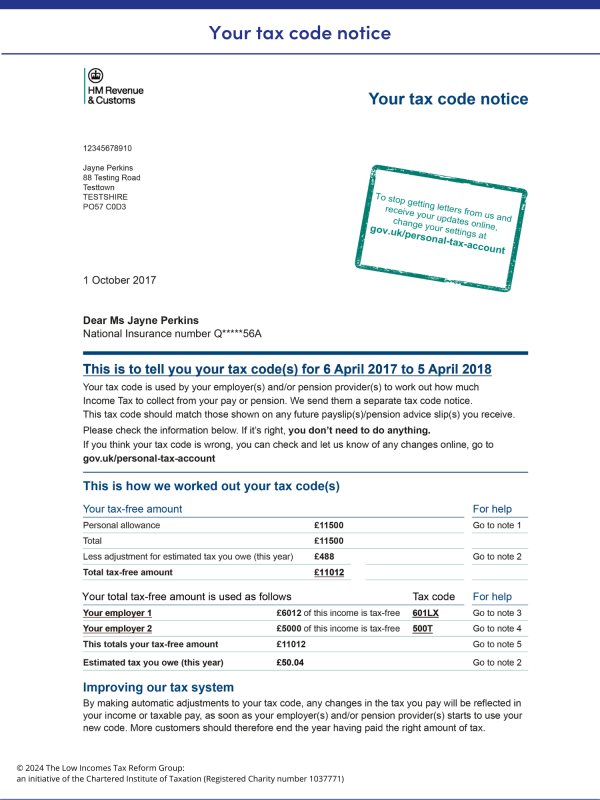PAYE coding notices
HMRC issue PAYE coding notices (known as a form P2) to let people know what their tax code is each year and if it changes during the tax year. On this page, we look at who gets a PAYE coding notice and how to check if it is correct. We explain how you can get your tax code changed if you think it is wrong.

Content on this page:
Who gets a PAYE coding notice
Although millions of people pay their tax under the PAYE system, not everyone needs a paper copy tax code notification each year (P2) – a PAYE coding notice.
If you do not receive a PAYE coding notice, you should be able to view your PAYE code in your Personal Tax Account.
If, for example, your tax-free amount is just the basic personal allowance, then you may only have received one PAYE coding notice – when you first started work or started to receive a pension. This is because if the amount of the basic personal allowance changes each year, HMRC and your employer (or pension provider) can update your tax code automatically by reference to the code letter ‘L’, without HMRC needing to contact you.
However, your tax code may be reduced or increased to take account of things like:
- untaxed income, such as rental property or savings income,
- underpaid tax from earlier years, and
- employment-related benefits, such as company cars or medical insurance.
In this case, HMRC should send you a PAYE coding notice each year, unless HMRC believe that a source of PAYE income is not chargeable to tax, or if you do not have a liability to tax on any PAYE-source income. HMRC usually send these notices in January for the tax year starting on the next 6 April.
Your circumstances can change during the tax year, so HMRC can amend your tax code at any time and send you a new PAYE coding notice.
Keep all your coding notices to check that HMRC have calculated your tax code correctly and that your employer is using the correct tax code for you.
How to check your PAYE coding notice
If you receive a paper PAYE coding notice (P2) through the post, the form will usually look like this:

Read the paragraphs below for detailed explanations. If you check your PAYE code online or via the Personal Tax Account, note that the layout may be slightly different.
You can split your PAYE coding notice into roughly five sections for checking the items under each sub-heading below.
Personal and contact information
This first section contains:
- your title (Mr, Mrs, Dr, Sir, etc.), your name and address and your National Insurance number (NINO) – contact HMRC as soon as you can if anything is wrong;
- a tax reference, usually in the form 123/500 or 123/A500 – this is your main employer’s or pension provider's PAYE scheme reference number;
- the date of issue of the notice.
Tax year
Note the tax year that the coding notice refers to: you may receive two PAYE coding notices for different years in the same day’s post.
Calculation of the tax code
In the calculation box, HMRC usually set out your personal allowances first and anything else that increases your tax-free amount, such as tax-deductible job expenses. These items are then added up.
Anything that reduces your tax-free amount, such as a reduction to collect unpaid tax or an estimate of untaxed interest, is then taken off.
This leaves you with a tax-free amount which, if positive, has the final digit dropped off. A letter is added at the end to give you your tax code. For example, for a taxpayer living in England, a tax-free amount of £4,921 becomes tax code 492L.
If the result is negative, you have a minus tax-free amount. The number has the final digit dropped off, a figure of one is taken away and the letter K is put before the result to give you your tax code. For example, again for an English taxpayer, a minus tax-free amount of £2,970 becomes tax code K296.
If you think anything in your tax code is wrong, contact HMRC as soon as possible. Do not expect your employer or pension provider to do this for you.
Employer(s) or pension provider(s)
The name of your employer or pension provider should not be wrong but if it is, contact HMRC.
If you are a pensioner, you might receive more than one pension from the same pension provider. If this is the case, you should check that you have a code number for each pension – they might have different PAYE scheme reference numbers, for instance. Again, if you need clarification, contact HMRC.
You should note that if you have two or more jobs or pensions, then HMRC will issue a tax code for each – they should be contained on the same coding notice. You should cross check them, to make sure that your tax position is correct. For example, if you have two jobs or pensions, each with the code 1257L, you are receiving double the amount of tax-free employment or pension income that you are entitled to throughout the year and are at risk of underpaying tax during the year. If, however, one job or pension has code 1257L and the other has code BR or 0T, you are more likely to be paying approximately the right amount of tax.
Notes
The coding notice provides a note for every item in the tax code calculation. These notes are intended to help you to check your tax code, but the way the tax rules work means this is not always straightforward.
Unpaid tax
If you have a ‘reduction to collect unpaid tax’ item in your code number, your coding notice will show the actual amount of unpaid tax. HMRC ‘gross up’ that figure – multiplying by 100 and dividing by 20 (if you pay tax at basic rate) – and reduce your tax-free amount by the result, so you pay extra tax on the grossed-up figure. Because of the delay in establishing that you have underpaid tax for a particular year, the underpaid tax may sometimes be collected in a later tax year, rather than in the current tax year.
For example, if you are owing £47 for the 2023/24 tax year, and you pay tax at 20%, the calculation box on the 2024/25 PAYE coding notice would look like this:
| This is how we worked out your tax code(s): | ||
| Personal allowance | £12,570 (go to Note 1) | |
| Reduction to collect unpaid tax £47 | £235 (go to Note 2) | |
| Total tax-free amount | £12,335 (go to Note 3) | |
The extra tax that you will pay at 20% because of having a £235 reduction in your tax-free amount will collect the £47 unpaid tax (£235 x 20% = £47).
If HMRC reduced your tax-free amount by £47, then you would only pay additional tax of £9.40 (£47 x 20%).
Tax-free pay and tax rates
The final numbered note on your coding notice tells you:
- the employment income you can receive in the tax year before you start to pay tax,
- how your tax-free pay has been allocated to your employment(s),
- the maximum amount of income that can be taxed at various tax rates, and
- when higher or additional rates of tax would start to be charged.
Special notes
Finally, you may see a ‘special note’. This note could ask you to check that your employer is not incorrectly deducting NIC from you, or it could advise you of an estimated amount of underpaid tax that may be owed at the end of the tax year because your tax code was reduced.
Look at the examples below to see how you can work out what your tax should be from your tax code. Please note that for the sake of simplicity, these examples ignore NIC, which may also be payable.
Getting your coding notice changed
The first thing to remember is that your employer cannot change your code number until they receive notification from HMRC. So, you need to contact HMRC to explain why the code needs to be changed.
You can do this in a number of ways, but normally doing this online should get faster results:
- You can use the facility called Check your income tax for the current year in your Personal Tax Account. You can then explore your tax-free amount and have individual entries changed.
- You can contact HMRC by phone or letter using the contact details on GOV.UK.
Missing income
Your coding notice is used by your employer or pension payer (but not for the state pension) to deduct tax from the payments made to you. If you have other taxable income, including the state pension, that is not included in your coding notice you should advise HMRC who will either amend your coding notice or require you to complete a self assessment return.
Coming from abroad
When you start working in the UK, you will have to complete a starter declaration. Your employer will pass the information on this form to HMRC. HMRC will use this information to work out what your PAYE code should be. They will then send your PAYE code to your employer, so they know how much tax to take from your employment income. They will also send you a PAYE coding notice (P2), which you can check as explained above.
See the examples below, which show how a PAYE code is calculated.
Claiming the personal allowance
The standard personal allowance is usually awarded to you automatically if you are an employee – if so, it will be factored into your tax code. You may have to meet certain criteria to get it if you are not an EEA citizen or a UK national – see our page Tax allowances for more information. You should contact HMRC if you think you have not been given a personal allowance in your tax code but you think that you are eligible.
A non-resident who is entitled to the personal allowance but has not been given it in the PAYE code may be asked to completeform R43to formally claim it.
The time limit for doing so is four years from the end of the tax year for which the claim is to be made. For example, allowances for the tax year 2024/25 (the year ending 5 April 2025) must be claimed by 5 April 2029.
More information
For HMRC’s information on understanding your coding notice, visit GOV.UK.
If you do not understand your tax code or think that it is wrong, contact HMRC.



